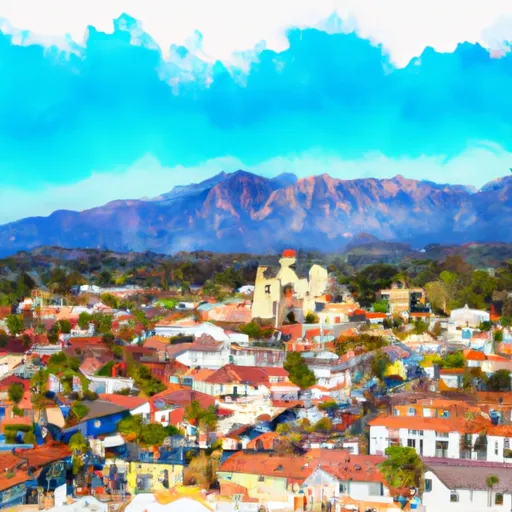-
 Snoflo Premium
Snoflo Premium
Get unlimited access to all our content
With no Ad interruptions! - Start Your Free Trial Login with existing account
Santa-Barbara
Eden Index
Climate
9.4
•
Recreation
3.4
•
Community
4.0
•
Safeguard
5.9/10

Santa Barbara, located on the central coast of California, offers a captivating blend of natural beauty and Mediterranean climate. Known as the "American Riviera," its climate is characterized by mild winters and warm, dry summers. With over 300 sunny days a year and an average temperature of 70°F (21°C), residents and visitors enjoy an outdoor lifestyle year-round.
The hydrology of Santa Barbara is primarily influenced by the Pacific Ocean and the Santa Ynez Mountains. The region benefits from the cool coastal breezes and occasional marine layer, providing a refreshing respite during warmer months. Additionally, the Santa Ynez Mountains contribute to the hydrology by providing a source of freshwater through rainfall and streams that flow into the Santa Barbara Channel.
Outdoor enthusiasts have a plethora of recreational opportunities to choose from in Santa Barbara. Its stunning coastline boasts pristine beaches perfect for swimming, surfing, and sunbathing. Hiking trails in the nearby mountains offer breathtaking views of the Pacific Ocean and opportunities to explore diverse ecosystems. The region is also renowned for its world-class wineries, providing visitors with the chance to indulge in wine tasting and vineyard tours.
Overall, Santa Barbara's idyllic climate, beautiful hydrology constituents, and abundant outdoor recreation opportunities make it a sought-after destination for those seeking a vibrant coastal lifestyle.
What is the Eden Index?
The Snoflo Eden Index serves as a comprehensive rating system for regions, evaluating their desirability through a holistic assessment of climate health, outdoor recreation opportunities, and natural disaster risk, acknowledging the profound impact of these factors on livability and well-being.
Climate Health Indicator (CHI): 9.4
Santa-Barbara receives approximately
560mm of rain per year,
with humidity levels near 77%
and air temperatures averaging around
16°C.
Santa-Barbara has a plant hardyness factor of
10, meaning
plants and agriculture in this region tend to thrive here all year round.
By considering the ideal temperature range, reliable water supplies, clean air, and stable seasonal rain or snowpacks, the Climate Health Indicator (CHI) underscores the significance of a healthy climate as the foundation for quality living.
A healthy climate is paramount for ensuring a high quality of life and livability in a region, fostering both physical well-being and environmental harmony. This can be characterized by ideal temperatures, reliable access to water supplies, clean air, and consistent seasonal rain or snowpacks.
Weather Forecast
Streamflow Conditions
Central California Coastal
Area Rivers
Central California Coastal
Snowpack Depths
Central California Coastal
Reservoir Storage Capacity
Central California Coastal
Groundwater Levels
Recreational Opportunity Index (ROI): 3.4
The Recreational Opportunity Index (ROI) recognizes the value of outdoor recreational options, such as parks, hiking trails, camping sites, and fishing spots, while acknowledging that climate plays a pivotal role in ensuring the comfort and consistency of these experiences.
Access to outdoor recreational opportunities, encompassing activities such as parks, hiking, camping, and fishing, is crucial for overall well-being, and the climate plays a pivotal role in enabling and enhancing these experiences, ensuring that individuals can engage in nature-based activities comfortably and consistently.
Camping Areas
| Campground | Campsites | Reservations | Toilets | Showers | Elevation |
|---|---|---|---|---|---|
| Fremont | 15 | 981 ft | |||
| Los Prietos | 37 | 1,088 ft | |||
| Middle Santa Ynez | 13 | 1,599 ft | |||
| Upper Oso | 25 | 1,166 ft |
Nearby Ski Areas
Catastrophe Safeguard Index (CSI):
The Catastrophe Safeguard Index (CSI) recognizes that natural disaster risk, encompassing floods, fires, hurricanes, and tornadoes, can drastically affect safety and the overall appeal of an area.
The level of natural disaster risk in a region significantly affects safety and the overall livability, with climate change amplifying these risks by potentially increasing the frequency and intensity of events like floods, fires, hurricanes, and tornadoes, thereby posing substantial challenges to community resilience and well-being.
Community Resilience Indicator (CRI): 4.0
The Community Resilience Indicator (CRI) recognizes that education, healthcare, and socioeconomics are crucial to the well-being of a region. The CRI acknowledges the profound impact of these elements on residents' overall quality of life. By evaluating educational resources, healthcare accessibility, and economic inclusivity, the index captures the essential aspects that contribute to a thriving community, fostering resident satisfaction, equity, and social cohesion.

